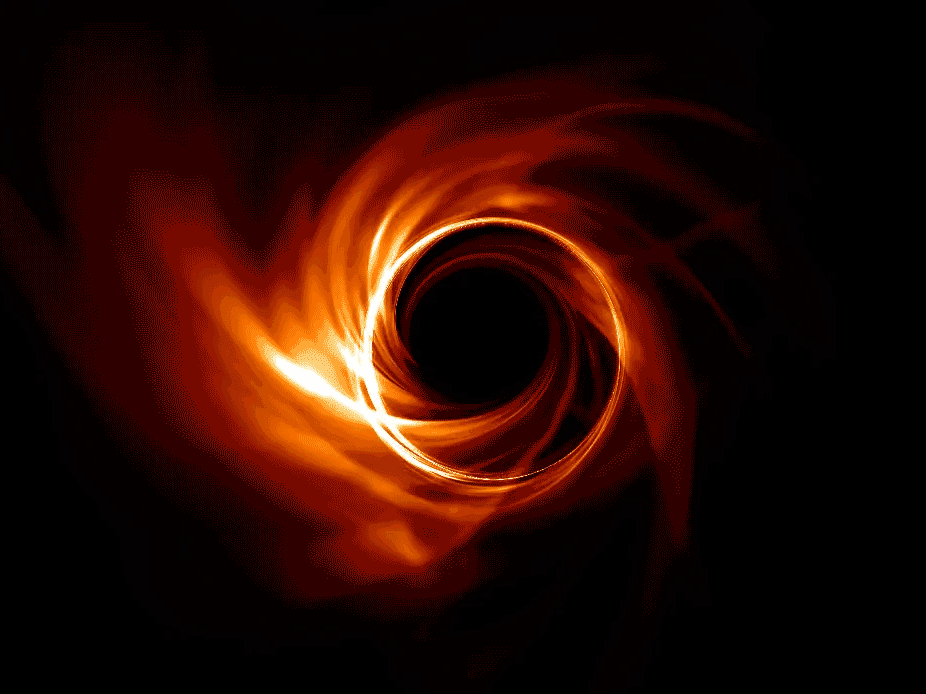Black Holes
Astronomers Spot Rare, Mid-Sized Black Hole in Our Galaxy
The black hole, if confirmed, is in the star cluster Omega Centauri, about 17,700 light-years away, and it could hold lessons about how such structures are formed
James Webb Telescope Detects Earliest Known Black Hole Merger, Just 740 Million Years After the Big Bang
The new observations could help explain how black holes became so massive in the early universe
Astronomers Discover a 'Sleeping Giant' Black Hole in Our Galaxy—the Second-Closest Known to Earth
Called Gaia BH3, the dormant black hole is 33 times more massive than the sun, making it the largest recorded stellar black hole in the Milky Way
Astronomers Capture Dazzling New Image of the Black Hole at the Milky Way's Center
The first image of the black hole taken in polarized light, the new view shows the supermassive structure's magnetic fields and hints that it could be hiding an enormous jet
Astronomers Discover the Brightest Known Object in the Universe, Shining 500 Trillion Times as Bright as the Sun
The quasar—a glowing, active core of a galaxy—has a black hole at its center that consumes more than a sun’s-worth of mass each day
This 'Game-Changer' Detector Will Hunt for Giant Ripples in Spacetime
Set to launch in 2035, the European Space Agency's LISA mission will listen for gravitational waves created by colliding black holes and neutron stars—and some might date nearly to the Big Bang
Astronomers Discover the Oldest Known Black Hole, Breaking a Record Set Last Year
The supermassive structure dates to about 400 million years after the Big Bang, and it’s particularly large for its age
Listen to the Center of the Milky Way Translated Into Sound
A new musical composition represents data from three NASA telescopes as a piece that was performed by an orchestral ensemble
Astronomers Spot the Oldest Black Hole Ever Seen, Shedding Light on the Early Universe
Dating to just 470 million years after the Big Bang, the ancient cosmic structure could help researchers understand how the first black holes formed
Gravitational Waves Create a Constant 'Hum' Across the Universe
Breakthrough research suggests the continuous ripples in spacetime could be caused by pairs of supermassive black holes, spiraling toward collisions
Astronomers Identify the Largest-Ever Cosmic Explosion
The burst is ten times brighter than any known exploding star and has lasted for more than three years
First-of-Its-Kind Image Captures a Black Hole's Shooting Jet
The finding could help reveal how black holes launch such high-energy ejections
See the Sharp New Image of a Supermassive Black Hole
Astronomers used machine-learning technology to improve a 2019 visualization of the M87 black hole, located some 54 million light-years away from Earth
Black Hole Hurtling Through Space Leaves a Trail of Stars in Its Wake
Researchers theorize a stream of stars 200,000 light-years long came from a black hole ejected from its galaxy
What Does the Universe Sound Like?
The Smithsonian Astrophysical Observatory and other researchers have melded astronomy and music to offer a new oeuvre
A Space Flash Detected in February Was a Black Hole Devouring an Unassuming Star
The bright light was the result of a rare cosmic occurrence known as a tidal disruption event
What the Image of the Milky Way's Black Hole Really Shows
This year’s picture of the swirling plasma around the massive object's edges will help to reveal more about the galaxy’s history and evolution
Astronomers Discover Closest Known Black Hole to Earth
Researchers believe there may be even nearer ones that have yet to be detected
This Powerful Gamma-Ray Blast Was the 'Brightest of All Time'
Astronomers are "in awe" of the high-energy explosion, probably caused by a giant star's death
This 18-Year-Old Recreated the ‘Entire Universe’ in Minecraft
From the video game's blocks, he built galaxies, a nebula, a black hole and the solar system
Page 1 of 3
:focal(560x560:561x561)/https://tf-cmsv2-smithsonianmag-media.s3.amazonaws.com/filer_public/4d/05/4d051c14-9155-4062-8244-aa19edabf81b/hubble-omegacent-crop-stsci-01j1x1rzvdzs3hv0s5vbhc7x0r.webp)
:focal(2000x2000:2001x2001)/https://tf-cmsv2-smithsonianmag-media.s3.amazonaws.com/filer_public/bb/6b/bb6bbcb6-6fa9-4c05-bca7-0c89fd918087/weic2413a.jpg)
:focal(580x331:581x332)/https://tf-cmsv2-smithsonianmag-media.s3.amazonaws.com/filer_public/19/32/19321ec4-4ae9-4749-ad51-7ec75adbf27a/gaia1.webp)
:focal(1000x1000:1001x1001)/https://tf-cmsv2-smithsonianmag-media.s3.amazonaws.com/filer_public/05/fd/05fd3550-7ef1-46e3-9229-188eb270a02b/sgra_polarimetric_press_image-032724-lores.jpg)
:focal(2093x1316:2094x1317)/https://tf-cmsv2-smithsonianmag-media.s3.amazonaws.com/filer_public/01/22/0122eed6-f4f1-41e4-bca4-5e359ed38826/eso2402a.jpg)
:focal(768x432:769x433)/https://tf-cmsv2-smithsonianmag-media.s3.amazonaws.com/filer_public/90/e3/90e3d1e3-4331-4a52-a628-a6fba5ba4d3d/lisa-2arms-gws-red2.webp)
:focal(640x366:641x367)/https://tf-cmsv2-smithsonianmag-media.s3.amazonaws.com/filer_public/60/33/603333f8-6856-4707-a8f4-5e3cb7da0640/gsfc_20171208_archive_e000402orig.jpg)
:focal(5984x3020:5985x3021)/https://tf-cmsv2-smithsonianmag-media.s3.amazonaws.com/filer_public/3d/f6/3df65ecd-5d50-4918-8236-4a663c66cb90/sonify_galactic_1.jpg)
:focal(1500x1143:1501x1144)/https://tf-cmsv2-smithsonianmag-media.s3.amazonaws.com/filer_public/32/59/32593cc4-b6e9-4025-8431-6231b3459423/uhz1.jpg)
:focal(1066x705:1067x706)/https://tf-cmsv2-smithsonianmag-media.s3.amazonaws.com/filer_public/c8/f4/c8f48b1e-6d24-4dd6-b137-0b343feb8457/gettyimages-st000710.jpg)
:focal(425x304:426x305)/https://tf-cmsv2-smithsonianmag-media.s3.amazonaws.com/filer_public/5c/db/5cdbe39e-548e-484a-80cc-a72cfcd84e34/blackhole_artists_impression.png)
:focal(640x500:641x501)/https://tf-cmsv2-smithsonianmag-media.s3.amazonaws.com/filer_public/46/0b/460bd2f8-4ee2-43a7-af3f-39d46f9d3901/eso2305a.jpeg)
:focal(288x288:289x289)/https://tf-cmsv2-smithsonianmag-media.s3.amazonaws.com/filer_public/c6/47/c647b94c-ad81-48ab-a705-577a3c14c866/m87_primo_single_bw8_no_scale_5000px.jpg)
:focal(960x549:961x550)/https://tf-cmsv2-smithsonianmag-media.s3.amazonaws.com/filer_public/96/4e/964e2115-345d-4945-b7b3-a88b9e11efba/hubble_runawayblackhole_stsci-01gx657xta7kn3a8rpsdxs9d07.png)
:focal(800x602:801x603)/https://tf-cmsv2-smithsonianmag-media.s3.amazonaws.com/filer_public/51/11/511110aa-d8b4-44fe-b4e5-88ed0e798f78/whattheuniversesoundslike-v1_web.jpg)
:focal(2362x1597:2363x1598)/https://tf-cmsv2-smithsonianmag-media.s3.amazonaws.com/filer_public/18/f4/18f4e941-b85b-45ae-b07c-52eaa6ca1f84/gettyimages-1237093074.jpg)

:focal(2560x1463:2561x1464)/https://tf-cmsv2-smithsonianmag-media.s3.amazonaws.com/filer_public/40/6b/406ba2df-3950-415d-8678-9d3ca96fd7e5/noirlab2227a.jpeg)
:focal(542x542:543x543)/https://tf-cmsv2-smithsonianmag-media.s3.amazonaws.com/filer_public/f6/6b/f66b5f64-1351-47db-898c-192a4acd0dc6/grb.jpeg)
:focal(1785x1003:1786x1004)/https://tf-cmsv2-smithsonianmag-media.s3.amazonaws.com/filer_public/0b/bb/0bbb359c-0284-4939-9fec-848fed3bd340/screen_shot_2022-10-13_at_43912_pm.png)